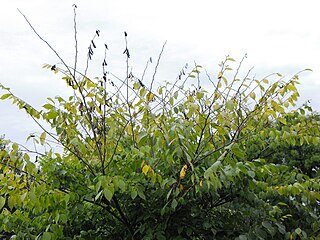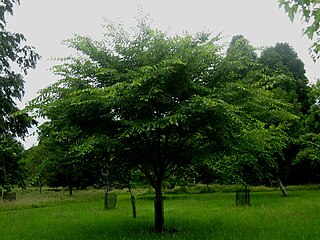
Dutch elm disease (DED) is caused by a member of the sac fungi (Ascomycota) affecting elm trees, and is spread by elm bark beetles. Although believed to be originally native to Asia, the disease was accidentally introduced into America and Europe, where it has devastated native populations of elms that did not have resistance to the disease. It has also reached New Zealand. The name "Dutch elm disease" refers to its identification in 1921 and later in the Netherlands by Dutch phytopathologists Bea Schwarz and Christine Buisman who both worked with Professor Johanna Westerdijk. The disease affects species in the genera Ulmus and Zelkova, therefore it is not specific to the Dutch elm hybrid.

Ulmus laevisPall., variously known as the European white elm, fluttering elm, spreading elm, stately elm and, in the United States, the Russian elm, is a large deciduous tree native to Europe, from France northeast to southern Finland, east beyond the Urals into Kyrgyzstan and Kazakhstan, and southeast to Bulgaria and the Crimea; there are also disjunct populations in the Caucasus and Spain, the latter now considered a relict population rather than an introduction by man, and possibly the origin of the European population. U. laevis is rare in the UK, however its random distribution, together with the absence of any record of its introduction, has led at least one British authority to consider it native. NB: The epithet 'white' elm commonly used by British foresters alluded to the timber of the wych elm.

Ulmus pumila, the Siberian elm, is a tree native to Central Asia, eastern Siberia, the Russian Far East, Mongolia, Tibet, northern China, India and Korea. It is also known as the Asiatic elm and dwarf elm, but sometimes miscalled the 'Chinese Elm'. It is the last tree species encountered in the semi-desert regions of central Asia. Described by Pallas in the 18th century from specimens from Transbaikal, Ulmus pumila has been widely cultivated throughout Asia, North America, Argentina, and southern Europe, becoming naturalized in many places, notably across much of the United States.

Ada Ciganlija, colloquially shortened to Ada, is a river island that has artificially been turned into a peninsula, located in the Sava River's course through central Belgrade, the capital of Serbia. The name can also refer to the adjoining artificial Lake Sava and its beach. To take advantage of its central location, over the past few decades, it was turned into an immensely popular recreational zone, most notable for its beaches and sports facilities, which, during summer seasons, can have over 100,000 visitors daily and up to 300,000 visitors over the weekend. Owing to this popularity, Ada Ciganlija has been commonly nicknamed "More Beograda", which was officially accepted as an advertising slogan in 2008, stylised as More BeogrADA.

Ulmus bergmannianaC.K.Schneid., commonly known as Bergmann's elm, is a deciduous tree found across much of China in forests at elevations of 1500–3000 m.

Ulmus laciniata(Trautv.) Mayr, known variously as the Manchurian, cut-leaf, or lobed elm, is a deciduous tree native to the humid ravine forests of Japan, Korea, northern China, eastern Siberia and Sakhalin, growing alongside Cerciphyllum japonicum, Aesculus turbinata, and Pterocarya rhoifolia, at elevations of 700–2200 m, though sometimes lower in more northern latitudes, notably in Hokkaido.

Ulmus davidianaPlanch., the David, or Father David, elm, is a small deciduous tree widely distributed across China, Mongolia, Korea, Siberia, and Japan, where it is found in wetlands along streams at elevations of 2000–2300 m (6,500–7,500 ft). The tree was first described in 1873 from the hills north of Beijing, China.
Ulmus pseudopropinquaWang & Li, occasionally known in the United States as the Harbin spring elm, is a small deciduous tree found only in Heilongjiang, the northeasternmost province in China. The tree has not been studied comprehensively, and it has been speculated it may be a natural hybrid of Ulmus davidiana var. japonica and Ulmus macrocarpa.

The field elm cultivar Ulmus minor 'Stricta', known as Cornish elm, was commonly found in South West England and Brittany until the arrival of Dutch elm disease in the late 1960s. The origin of Cornish elm in England remains a matter of contention. It is commonly assumed to have been introduced from Brittany. It is also considered possible that the tree may have survived the ice ages on lands to the south of Cornwall long since lost to the sea. Henry thought it "probably native in the south of Ireland". Dr Max Coleman of Royal Botanic Garden Edinburgh, arguing in his 2002 paper on British elms that there was no clear distinction between species and subspecies, suggested that known or suspected clones of Ulmus minor, once cultivated and named, should be treated as cultivars, preferred the designation U. minor 'Stricta' to Ulmus minor var. stricta. The DNA of 'Stricta' has been investigated and the cultivar is now known to be a clone.

The Chinese Elm cultivar Ulmus parvifolia 'Frosty' was intended primarily as a dwarf variety.
The Chinese Elm cultivar Ulmus parvifolia 'Glory' is one of the early American selections, best known for its winter hardiness.
The European White Elm cultivar Ulmus laevis 'Colorans' was listed as U. effusa var. colorans by Kirchner in Petzold & Kirchner, Arboretum Muscaviense (1864).
Ulmus laevis var. celtideaRogow. is a putative variety of European White Elm first described by Rogowicz, who found the tree in 1856 along the river Dnjepr near Chernihiv in what is now northern Ukraine. The type specimen is held at the National Herbarium of Ukraine. The variety was first named as Ulmus pedunculata var. celtidea. Litvinov (1908) considered it a species, calling it Ulmus celtideaLitv., a view not upheld by other authorities.

The possible Field Elm cultivar U. minor 'Planifolia' was listed by Loudon in Arboretum et Fruticetum Britannicum (1838) as Ulmus campestris (:minor) var. planifolia, the flat-leaved elm. Green opined that the species was uncertain.
Ulmus parvifolia var. coreana, the Korean elm, is a variety of the Chinese elm Ulmus parvifolia, native to Korea.

Stegophora ulmea is a foliar disease of elms commonly known as black spot of elm, twig blight, and elm leaf scab. It is characterized by yellow spots that become black spots on the leaves. The pathogen is an ascomycete fungus native to North America. Stegophora ulmea is its teleomorph name. It has two anamorph names, Gloeosporium ulmicolom referring to the macroconidia stage and Cylindrosporella ulmea referring to the microconidia stage. This pathogen was formerly known as Gnomonia ulmea.

Ulmus parvifolia, commonly known as the Chinese elm or lacebark elm, is a species native to eastern Asia, including China, Taiwan, Japan, North Korea, and Vietnam. It has been described as "one of the most splendid elms, having the poise of a graceful Nothofagus".
Ulmus×mesocarpaM. Kim & S. Lee is a natural hybrid elm which is a cross of Ulmus macrocarpa with Japanese elm Ulmus davidiana var. japonica discovered on Seoraksan near the city of Sokcho on the eastern coast of South Korea. The tree is endemic to the provinces of Gangwon-do, Injegun, Bukmyeon, Yongdaeri, and Baekdamsa.











